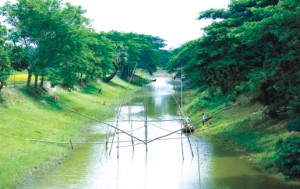|
Environment
Preserving a Rich and Diverse Ecosystem
ANIKA HOSSAIN
Amena Begum is from a remote village in Burigoalini. Burigoalini is not the ideal location for rice farming and there is limited availability of transportation making it difficult for Amena to earn a decent living. Amena and her family had to make do with meals of one boiled potato a day, until she was introduced to the IPAC project, funded by USAID, which helped her develop an interest in aquaculture. She is now the proud owner of several fish ponds she built about six months ago. Her wish to send her children to school and to the big city for higher education is no longer a distant dream. Simple ideas such as fish farming and vegetable gardening have changed the lives of many in this small village and several others in the Sundarbans area.
 |
Young artist presenting their work to the guests of honour. |
Bangladesh with its abundant wetlands and forests, hosts a rich eco-system which provides a livelihood for the local population. For many generations, the local people have enjoyed an abundance of natural resources. However, the lack of proper management has caused depletion in these resources over time, as a result of which the current generation has inherited a less biologically diverse ecology.
Projects are being developed and efforts are being made by the government, developmental organisations as well as the civil society in order to conserve and sustainably manage the limited natural resources available to the people, so they can make best use of them as Amena Begum has.
In June 2008, USAID came up with the concept of collaborative management, which involves local communities and other stakeholders in the management and conservation of forest lands, wetlands and other natural resources. This became known as the Integrated Protected Area Co-Management Project (IPAC).This was implemented by the Ministry of Environment and Forest and Ministry of Fisheries and Livestock with technical support from partners led by the International Resources Group (IRC).
The main aim of the project is to benefit men, women and children from rural poor households in 25 targeted project areas in the Sundarbans, Chittagong Hill Tracts, Sylhet, South Eastern and Central Clusters. It is a 5 year project which started from June 5, 2008 and will continue to June 4, 2013. This approach of co-management, empowers local people by giving them a voice in a decision making process which involves the proper use of their lands. The main incentive for them to participate is the financial benefits and the promise of a better standard of living.
Another project with a similar goal is The Wetland Biodiversity Rehabilitation Project (WBRP), which is supported by the Department of Fisheries of the Ministry of Fisheries and Livestock, the Bangladesh Water Development Board of the Ministry of Water Resources and the German Federal Ministry for Economic Cooperation and Development through the GTZ. The aim of this project is to increase wetland biodiversity, restore vital freshwater fishery habitats and improve the livelihoods of the local wetland people in the eastern part of Pabna. Local NGO's in this area are forming community based organizations (CBO's) which includes representation from several villages using the same wetland or flood plain area. These organizations also aim to empower the local people by involving them in the decision making process regarding their land.
Through this project, about 50 hectares of wetlands are being deepened to replenish aquatic life during the dry summers, providing the fish population with over 20,000 hectares in which to thrive. 10 wetland sanctuaries are also being established to protect aquatic life from exploitation. Endangered fishes, swamp trees and other aquatic plants are also being reintroduced to restore habitats in these areas.
 |
The rich and diverse ecology of Bangladesh. |
This year, to raise further awareness on biodiversity, International Day of Biological Diversity and the World Environment Day, were celebrated in an altogether different way. The organisers of IPAC and WBRP jointly put together a unique art and writing exhibition. The purpose of the exhibition which took place earlier in May, was to increase awareness about biodiversity among the youth of our current generation. The young talents displaying their work were were students between the ages of 8-15 from across the country. Each student produced a writing or painting, portraying what they understood about the concept of biodiversity.
The winners were invited for a second exhibition on the 4th of October 2010 at the US Embassy to showcase their work. The organisers divided their projects into 6 clusters, Chittagong, Satkhira, Pabna, Sylhet, Cox's Bazar and the Central Cluster that comprises the Madhupur forest region. Two winners were chosen from each cluster, one for writing and one for art work.
The depth of understanding of these youngsters and the variety of work displayed was stunning. There were images of rural landscape, rivers and lush green lands. Aquatic life, land animals and birds were drawn in abundance. Plant life flourished on the colourful canvases. The writings featured calls of help to protect nature and wildlife.
The winners of the writing section were Md. Atikul Islam, Shengmapro Marma, Md. Abul Kashem, Kaneez Shuborna, Md. Rafizur Rahman and Opik Dev Opi. And the winning painters included Monia Akter, Tanjina Akter Shahinur, Taspia Kanta Piata, Ayesha Khatun, Shapna Akter and Ashim Sharma.
The exhibition was inaugurated by USAID Bangladesh Mission Director Denise Rollins, Charge d'affairs, U.S. Embassy, Dhaka, Nicholas Dean, Mohammed Abdul Motaleb, chief conservator of Forests, Bangladesh Forest Department and Hans Hinrich Schnelle, First Secretary, Development Cooperation, German Embassy in Dhaka.
The enthusiastic participation of children from all over the country shows the level of awareness amongst the youth about the impact of biodiversity on their lives now and in the foreseeable future. The current generation must carry on the sustainable management of resources to improve the standard of living in Bangladesh.
Copyright
(R) thedailystar.net 2010 |
